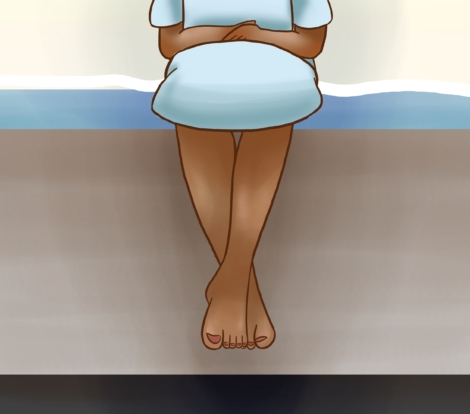“Are you drinking enough water?”
My family doctor clicked through something on her computer, occasionally peering at me through wire-rimmed glasses. I was in her office for the third time in several years, attempting to get a medical explanation for what she scribbled down as “dysmenorrhea” — severe cramps that hit up to a week before my period began and intensified during it, sometimes rendering me incapable of carrying out daily activities.
“Yes, about four litres a day,” I responded. These kinds of questions were typical. By this time, she had prescribed me a variety of painkillers, advised me to improve my diet, and speculated that I might be out of shape, despite my membership on the cross-country team. None of this had done anything for my pain, and that day, I was determined not to leave her office without an ultrasound referral.
My dad knows all too well what it’s like to get a call from me, asking him to come to where I am collapsed on the sidewalk mere minutes from my front door, cramps eating through my stomach. Once, my mother came home to find me crumpled on the floor, crushing pieces of homework in my hands to distract myself from the all-consuming pain. And yet, none of this compared to the time when I was 12 and passed out in a mall on the first day of my period, the ache radiating from my lower abdomen to dull the rest of my body. Somehow, despite all of this, I was worried that what I felt was merely a figment of my imagination, manageable if only I were stronger.
I did manage to obtain my referral that day and to schedule an ultrasound appointment. A few weeks later, I received the report: no abnormalities found. In some ways, perhaps testing positive for something — anything — would have presented me with a sense of relief, because it would mean that I wasn’t overreacting. But in many other ways, had the doctors found something, it could have been the beginning of a life structured around a chronic, incurable, and often misunderstood condition: endometriosis.
The Department of Obstetrics and Gynecology at the University of California Los Angeles defines ‘endometriosis’ as a condition wherein “the tissue that makes up the uterine lining [in the womb] is present on other organs inside your body.” In other words, tissue from a woman’s uterus can crawl into her fallopian tubes, spread into her pelvic cavity, and even plant itself in her lungs. There, it builds up, breaks down, and bleeds just as normally-located uterine tissue does. Eventually, scar tissue develops to mesh internal organs together. Not all women with endometriosis suffer symptoms, but those who do report intense pain with or without their period and sometimes even during sex.
It’s difficult to understand the extent of the pain without experiencing it, but one woman who lives with the condition likened the sensation to being hit in the ovaries with an axe. Others have written that it feels “like my uterus is sitting on a bed of razor blades,” or “like someone is taking a cheese grater to my cervix.” On top of this, it comes with high rates of infertility; for women who want to have a child, their physical pain might be compounded by the emotional strain of being unable to reproduce.

FIONA TUNG/THE VARSITY
For a condition that one in 10 women live with, endometriosis is remarkably difficult to obtain a diagnosis for. Among those who are aware of its existence, this difficulty is notorious. For starters, the condition takes an average of eight years to be recognized by a physician. The reasons for this are various, grounded in both the medical and the social.
To begin with the medical, the condition’s symptoms are largely invisible; they’re also often misunderstood to be those of gastrointestinal, rather than reproductive, disorders. A laparoscopy, in which a tube probes the interior of the belly for out-of-place uterine tissue, is understood as the only definitive way to determine if a patient has endo. Due to the risks it carries as a surgical procedure, it’s recommended by physicians with caution.
The barriers to diagnosing endometriosis are also incredibly social. Up until recently — and continuing today, depending on cultural context — strong taboos around discussing reproductive issues like fertility and menstruation have discouraged women from being open about their experiences. The consequences of this include reduced knowledge on the severity of symptoms, as well as increased difficulty for professionals to construct diagnoses. Compounding this is the physicians’ response to endometriosis symptoms. Suffering extreme period pain has been normalized to the extent that many health care providers won’t investigate it further. Instead, women are told to take painkillers — as I was — and to wait it out.
Beyond this, there’s a well-recognized trend demonstrating that health care professionals take women’s pain less seriously than men’s. Experts acknowledge that women endure and declare pain more frequently and of greater intensity, but they are less likely to receive sufficient treatment for symptoms. Researchers Diane Hoffmann and Anita Tarzian of the University of Maryland found that gender bias prompts physicians to dismiss a woman’s pain, unless there is an explicit, objective reason not to. In other words, women detailing their pain are perceived as sensitive or hysterical, and are at risk of having physical ailments attributed to psychiatric conditions.
At different intersections, this difficulty is only exacerbated. Endometriosis is perceived to be a white woman’s condition, and women of colour suffer the consequences of this. “The symptoms present the same way, but the complaints that women of color bring to a provider aren’t taken as seriously sometimes, and they aren’t properly diagnosed,” Oluwafunmilola Bada, Associate Professor of Obstetrics and Gynecology at Howard University, told SELF Magazine.
Even if a diagnosis is obtained, there is no real cure for the condition as surgeries to remove the uterus and ovaries aren’t always effective, and pain can flare back up when temporary treatments are halted. Living with endometriosis is a daily affair that is drawn out over years. As sufferer and advocate Lara Parker put it, “chronic pain means chronic.” Living with a long-term condition, especially one that is so misunderstood, can bleed into all aspects of an individual’s life, with implications for their mental health, family, relationships, and career.
Endometriosis is slowly gaining ground in terms of awareness, which will hopefully prompt improvements in the way that it is addressed. Celebrities like Halsey and Tia Mowry have been vocal about their experiences; Girls’ Lena Dunham has also been transparent about her diagnosis. As a result, it’s not as obscure as it was 10 years ago. However, the persisting difficulty that women face when trying to have their pain understood, their health conditions recognized, and their symptoms managed can be incredibly damaging. It compromises their quality of life as well as the integrity of the health care system, which professes to serve everyone equally but far to go before this becomes evident in practice.


